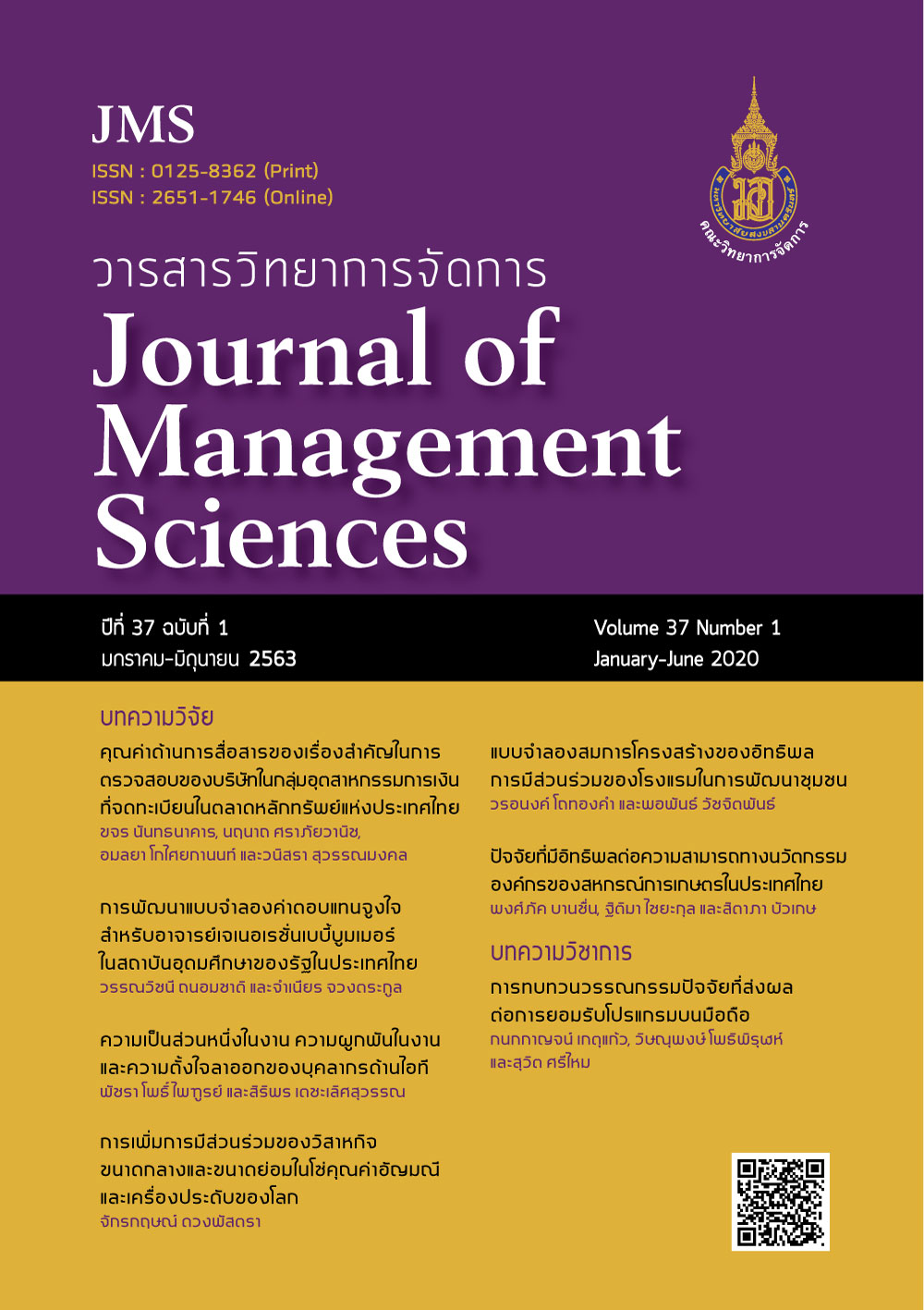ปัจจัยที่มีอิทธิพลต่อความสามารถทางนวัตกรรมองค์กรของสหกรณ์การเกษตรในประเทศไทย
Main Article Content
บทคัดย่อ
การปรับตัวของสหกรณ์การเกษตรในประเทศไทยสู่การสร้างความสามารถทางนวัตกรรมองค์กรอย่างเป็นระบบมีความจำเป็นอย่างยิ่ง เพื่อเสริมสร้างประสิทธิภาพการดำเนินงานและความได้เปรียบในการแข่งขัน การศึกษาครั้งนี้มีวัตถุประสงค์เพื่อศึกษาอิทธิพลของการมุ่งเน้นการตลาด การมุ่งเน้นการประกอบการ การมุ่งเน้นโซ่อุปทาน และการมุ่งเน้นการเรียนรู้ที่มีต่อความสามารถทางนวัตกรรมองค์กรของสหกรณ์การเกษตรในประเทศไทย โดยการเก็บข้อมูลด้วยแบบสอบถามจากการสุ่มตัวอย่างจากสหกรณ์การเกษตรไทย จำนวน 339 ตัวอย่าง และวิเคราะห์ข้อมูลด้วยการวิเคราะห์ถดถอยพหุคูณแบบขั้นตอน ผลการวิจัยพบว่า การมุ่งเน้นการเรียนรู้ การมุ่งเน้นการประกอบการ และการมุ่งเน้นโซ่อุปทาน มีอิทธิพลทางบวกสามารถร่วมกันพยากรณ์ความสามารถทางนวัตกรรมองค์กรของสหกรณ์การเกษตรในประเทศไทย
ได้ร้อยละ 69.28 (p < 0.05) โดยการมุ่งเน้นการเรียนรู้มีอิทธิพลทางบวกกับความสามารถทางนวัตกรรมองค์กรมากที่สุด ตามด้วยการมุ่งเน้นการประกอบการและการมุ่งเน้นโซ่อุปทาน การวิจัยนี้สะท้อนให้เห็นถึงความสำคัญของการบริหารจัดการองค์ความรู้ ความมุ่งมั่นในการแสวงหาโอกาสทางธุรกิจและการทำงานร่วมกันกับคู่ค้าที่เกี่ยวข้องในโซ่อุปทาน ในฐานะของปัจจัยผลักดันที่สำคัญในการพัฒนาให้เกิดความสามารถทางนวัตกรรมองค์กรที่นำไปสู่การเสริมสร้างศักยภาพในการแข่งขันของสหกรณ์การเกษตรในประเทศไทย
Article Details

อนุญาตภายใต้เงื่อนไข Creative Commons Attribution-NonCommercial-NoDerivatives 4.0 International License.
บทความที่ตีพิมพ์ถือเป็นลิขสิทธิ์ของวารสารวิทยาการจัดการ มหาวิทยาลัยสงขลานครินทร์ อย่างไรก็ตาม กองบรรณาธิการไม่สงวนลิขสิทธิ์ในการทำซ้ำ คัดลอก หรือเผยแพร่ แต่จะต้องอ้างอิงให้ถูกต้องตามหลักวิชาการ
เอกสารอ้างอิง
Akman, G., & Yilmaz, C. (2008). Innovative capability, innovation strategy and market orientation: an empirical analysis in Turkish software industry. International journal of innovation management, 12(1), 69-111.
Baker, W. E., & Sinkula, J. M. (1999). Learning Orientation, Market Orientation, and Innovation: Integrating and Extending Models of Organizational Performance. Journal of Market-Focused Management, 4(4), 295-308.
Brewer, P. C., & Speh, T. W. (2000). Using the Balance scorecard to Measure supply Chain Performance. Journal of Business Logistics, 21(1), 75-95.
Calantone, R. J., Cavusgil, S. T., & Zhao, Y. (2002). Learning orientation, firm innovation capability, and firm performance. Industrial Marketing Management, 31(6), 515-524.
Defee, C. C., & Stank, T. P. (2005). Applying the strategy-structure-performance paradigm to supply chain environment. International Journal of Logistics Management, 16(1), 159-178.
Deshpande, R., & Webster, F. (1989). Organizational culture and marketing: defining the research agenda. Journal of Marketing, 53(1), 3-15.
Esper, T. L., Defee, C. C., & Mentzer J. T. (2010). A Framework of Supply Chain Orientation. International Journal of Logistics Management, 21(2), 161-179.
Germain, R., & Iyer, K. N. (2006). The Interaction of Internal and Downstream Integration and Its Association with Performance. Journal of Business Logistics, 27(2), 29-52.
Guan, J., & Ma, N. (2003). Innovative capability and export performance of Chinese firms. Technovation, 23(9), 737-747.
Huber, G. P. (1991). Organizational Learning: The Contributing Processes and Literatures. Organization Science, 2(1), 88-115.
Hurley, R. F., Hult, T. M., & Knight G. A. (2005). Innovativeness and Capacity to Innovate in a Complexity of Firm-Level Relationships: A Response to Woodside 2004. Industrial Marketing Management, 34(3), 281–83.
Hult, T. M., Hurley, R. F., & Knight, G. A. (2004). Innovativeness: Its Antecedents and Impact on Business Performance. Industrial Marketing Management, 33(5), 429-438.
Johnson, J. D., Meyer, M. E., Berkowitz, J. M., Ethington, C. T., & Miller, V. D. (2006). Testing Two Contrasting Structural Models of Innovativeness in a Contractual Network. Human Communication Research, 24(2), 320-348.
Keskin, H. (2006). Marketing Orientation, Learning Orientation, and Innovation Capabilities in SMEs: An Extended Model. European Journal of Innovation Management, 9(4), 394-417.
Kohli, A. K., & Jaworski, B. J. (1990). Market Orientation: The Construct, Research Propositions, and Managerial Implications. Journal of Marketing, 54(2), 1-18.
Lee, S. M., & Peterson, S. J. (2000). Culture, Entrepreneurial Orientation, and Global Competitiveness. Journal of World Business, 35(4), 401-416.
Lee, T. S. & Tsai, H. J. (2005). The Effects of Business Operation mode on Market Orientation, Learning Orientation and Innovativeness. Industrial Management and Data Systems, 105(3), 325-348.
Leekpai, P. (2014). Factors Affecting the Innovativeness of Hotel Business in Southern Border Provinces of Thailand. Modern Management Journal, 12(1), 11-21.
Lumpkin, G., & Dess, G. (1996). Clarifying the Entrepreneurial Orientation Construct and Linking It to Performance. The Academy of Management Review, 21(1), 135-172.
Manu, F. (1992). Innovation Orientation, Environment and Performance: A Comparison of U.S. and European Markets. Journal of International Business Studies, 23(2), 333-359.
McAfee, B., Glassman, M. & Honeycutt, E. D. (2002). The effects of Cultural and Human Resource Management Policies on Supply Chain Management Strategy. Journal of Business Logistics, 23(1), 1-18.
Min, S., Mentzer, J.T. & Ladd, R.T. (2007). A Marketing Orientation in Supply Chain Management. Journal of the Academy of Marketing Science, 35(4), 507-522.
Morgan, N. A., Vorhies, D. W., & Mason C. H. (2009). Market orientation, marketing capabilities, and firm performance. Strategic Management Journal, 30(8), 909-920.
Narver, J., & Slater, S. (1990). The Effect of a Market Orientation on Business Profitability. Journal of Marketing, 54(4), 20-35.
National Innovation Agency. (n.d.). National Innovation Agency (Public Organization). Retrieved October 15, 2019, from https://www.mhesi.go.th/main/th/org/1511
Noble, C., Sinha, R., & Kumar, A. (2002). Market Orientation and Alternative Strategic Orientations: A Longitudinal Assessment of Performance Implications. Journal of Marketing, 66(4), 25-39.
Office of Natural Resources and Environmental Policy and Planning (2016). Gross domestic product composition by sector. Retrieved October 20, 2019, from http://www.onep.go.th/env_data/2016/01_2/
Peng, C. (2008). The Relationships between the Antecedents of Innovativeness and Business Performance. Proceeding of the 2008 International Symposium on Electronic Commerce and Security, 805-809.
Phasuk, W. (2014). Market Orientation and Learning Orientation in Improving Innovativeness and Organizational Performance of Medium Sized Industrial Businesses. Journal of Public and Private Management, 21(2), 102-126.
Rhee, J., Park, T., & Lee, D. H. (2010). Drivers of innovativeness and performance for innovative SMEs in South Korea: Mediation of learning orientation. Technovation, 30(1), 65-75.
Rodrigues, A., Stank, T. P., & Lynch, D. (2004). Linking Strategy, Structure, Process and Performance in Integrated Logistics. Journal of Business Logistics, 25(2), 65-94.
Sinkula, J., Baker, W., & Noordewier, T. (1997). A Framework for Market-Based Organizational Learning: Linking Values, Knowledge, and Behavior. Journal of the Academy of Marketing Science, 25(4), 305-318.
Stank, T.P., Daugherty, P.J. & Ellinger, A.E. (1999). Marketing/logistics integration and firm performance. International Journal of Logistics Management, 10(1), 11-24.
Stevenson, H. H., & Jarillo, J. C. (1990). A Paradigm of Entrepreneurship: Entrepreneurial Management. Strategic Management, 11, 17-27.
Tan, C. (2007). Sources of competitive advantage for emerging fast growth small-to-medium enterprises: the role of business orientation, marketing capabilities, customer value, and firm performance. (Doctor of Philosophy). Royal Melbourne Institute of Technology Melbourne.
Wang, C., & Ahmed, P. (2004). The Development and Validation of the Organizational Innovativeness Construct Using Confirmatory Factor Analysis. European Journal of Innovation Management, 7(4), 303-313.
Weiers, R. M. (2005). Introduction to Business Statistics: International Student Edition. (5th ed.). Pennsylvania, USA: Duxbury Press, Thomson.
Wiklund, J. (1999). The Sustainability of the Entrepreneurial Orientation Performance Relationship. Entrepreneurship Theory & Practice, 24(1), 37-48.
Wiklund, J., & Shepherd, D. (2005). Entrepreneurial Orientation and Small Business Performance: a Configurational Approach. Journal of Business Venturing, 20(1), 71-91.

